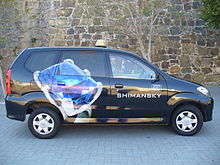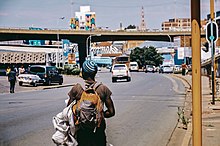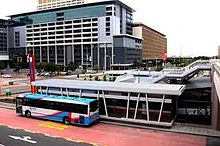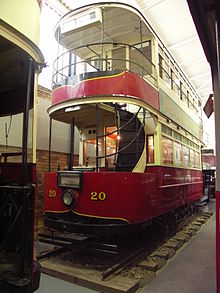Transport in South Africa
Different methods of transport in South Africa include roads, railways, airports, water, and pipelines for petroleum oil. The majority of people in South Africa use informal minibus taxis as their main mode of transport. BRT has been implemented in some South African cities in an attempt to provide more formalised and safer public transport services. These systems have been widely criticised due to their large capital and operating costs. A "freeway" is different from most countries as certain things are forbidden which include certain motorcycles, no hand signals, and motor tricycles. South Africa has many major ports including Cape Town, Durban, and Port Elizabeth that allow ships and other boats to pass through, some carrying passengers and some carrying petroleum tankers.
Roads
The national speed limit is 60 km/h in residential areas and 120 national roads/freeways/motorways.


In 2002 the country had 362,099 km of highways, 73,506 km (17%) of which was paved (including 239 km of expressways).[1]
In South Africa, the term freeway differs from most other parts of the world. A freeway is a road where certain restrictions apply.[2] The following are forbidden from using a freeway:
- a vehicle drawn by an animal;
- a pedal cycle (such as a bicycle);
- a motor cycle having an engine with a cylinder capacity not exceeding 50 cm3 or that is propelled by electrical power;
- a motor tricycle or motor quadrucycle;
- pedestrians
Drivers may not use hand signals on a freeway (except in emergencies) and the minimum speed on a freeway is 60 km/h (37 mph). Drivers in the rightmost lane of multi-carriageway freeways must move to the left if a faster vehicle approaches from behind to overtake.
Despite popular opinion that "freeway" means a road with at least two carriageways, single carriageway freeways exist, as is evidenced by the statement that "the roads include 1400 km of dual carriageway freeway, 440 km of single carriageway freeway and 5300 km of single carriage main road with unlimited access."[3] The Afrikaans translation of freeway is snelweg (literally fast road or expressway).
Road Transport
The Department of Transport is responsible for the regulation of all transportation in South Africa, including public transport, rail transportation, civil aviation, shipping, freight, and motor vehicles. According to the Department's vision statement, "Transport [is] the heartbeat of South Africa's economic growth and social development!"[4]
Minibus Taxis
Minibus Taxis are the predominant form of transport for people in urban areas of South Africa.[5] This is due to their availability and affordability to the public.[6] Most minibus taxis are not subsidized by the state and the taxi industry is notorious for using vehicles that are not well maintained are that are often not roadworthy to keep costs low.[7] Because many taxi owners own just a few taxis and each owner may choose to manage their business differently, there is not much known as to the inner workings of the industry that is rife with violence. Since 1994 there have been efforts to formalize the industry but as taxi organisations often don't abide by labour regulations, relationships between taxi operators and the state are often strained.

Cape Town and MyCiTi IRT
The City of Cape Town has made it clear that developing public transportation must be a priority, if it is to achieve its long-term developmental goals. As such, the City has planned out the development of an Integrated Rapid Transit (IRT) system called "MyCiTi IRT". In 2007, the construction of this system began with the implementation of Cape Town's "Bus Rapid Transit" system. This first phase has been designed to enable easy integration of other forms of public transport - ranging from cycling to South Africa's famous minibuses in later phases of the IRT development [8] - including rail transit, seen currently as "the backbone of public transportation in Cape Town."[9]
Railways
In 2000, South Africa had 20,384 km of rail transport, all of it narrow gauge. 20,070 km was 1,067 mm (3 ft 6 in) gauge (9,090 km of that electrified), with the remaining 314 km 610 mm (2 ft) gauge. The operation of the country's rail systems is accomplished by Transnet subsidiaries Transnet Freight Rail, Shosholoza Meyl, Metrorail, Transnet Engineering, Protekon et al.
A feasibility study is to be conducted into the construction of a 720 km of 1,435 mm (4 ft 8+1⁄2 in) (standard gauge) line from Johannesburg to Durban for double-stack container trains.[10]
On 2010-06-07 the Gautrain opened between Oliver R Tambo International Airport (ORTIA) and Sandton. This is the first stage of a standard gauge passenger line connecting Johannesburg, Pretoria and ORTIA.[11]
Links exist to Botswana, Lesotho, Namibia, Swaziland, and Zimbabwe. Railways linking Mozambique are under repair.
Transportation systems in nearby countries
 Angola
Angola Tanzania same gauge as far as Dar es Salaam – transshipment to 1,000 mm (3 ft 3+3⁄8 in) gauge at Kidatu
Tanzania same gauge as far as Dar es Salaam – transshipment to 1,000 mm (3 ft 3+3⁄8 in) gauge at Kidatu Malawi
Malawi Congo
Congo Botswana
Botswana Lesotho
Lesotho Mozambique, under repair
Mozambique, under repair Namibia
Namibia Swaziland
Swaziland Zambia
Zambia Zimbabwe
Zimbabwe
Airports
Runways in South Africa
| Runway | <914 m | 914/1 523 m | 1 524/2 437 m | 2 438/3 047 m | >3 047 m | Total |
|---|---|---|---|---|---|---|
| Paved | 11 | 67 | 50 | 5 | 10 | 143 |
| Unpaved | 252 | 298 | 34 | 584 |
International Airports and Airlines
South Africa has international airports in four cities: Johannesburg, Cape Town, Durban and Nelspruit. The main international airports are in Johannesburg, and to a lesser extent Cape Town. Nespruit's international airport mainly serves travellers en route to the Kruger National park.[12]
There are many international airlines travelling to South Africa, giving travellers a healthy number of options. These include British Airways, Delta Airlines, Ethiopian Airways, Kenya Airways, Qantas, Singapore Airlines, South African Airways, Swiss International Air Lines, Thai Airways, Turkish Airlines, Virgin Atlantic, Air Mauritius, Air Namibia, Air Botswana , Air France, KLM, Lufthansa, Alitalia, Malaysia Airlines and Qatar Airways.[13]
Water
South Africa's major ports and harbours are Cape Town, Durban, East London, Mossel Bay, Port Elizabeth, Richards Bay, George and Saldanha Bay. In 2006 the new port is to open: Ngqura, at Coega, which is 20 km northeast of Port Elizabeth. The administration and operation of the country's port facilities are done by two subsidiaries of Transnet, the Transnet National Ports Authority and South African Port Operations (SAPO).
As of March 2018, the merchant marine consisted of 15 ships totalling 431,133 GT.
Pipelines
There are 931 km of crude oil pipeline transport, 1,748 km for other petroleum products, and 322 km for natural gas. Petronet, a subsidiary of Transnet, which in turn is majority-owned by the government, is principally responsible for the operation of South Africa's pipelines.
Tramways

A number of urban tramway systems operated in South Africa but no longer do so. The last system (in Johannesburg) began in 1890 as Rand Tramway (electrified in 1906) and ceased operations in 1961.[14]
References
- ^ CIA World Factbook
- ^ Road Traffic Act No 29 of 1989 Archived 17 June 2011 at the Wayback Machine
- ^ "Transportation: Roads". South Africa:– Stats and Facts. Retrieved 15 June 2010.
- ^ http://www.transport.gov.za/Home/AboutUs.aspx
- ^ "Minibus Taxis and Road Safety". Arrive Alive. Retrieved 14 September 2018.
- ^ "The minibus taxi industry in South Africa: A servant for the urban poor?". Polity.org.za. Retrieved 14 September 2018.
- ^ "Minibus taxis | Getting Around | Johannesburg". www.inyourpocket.com. Retrieved 14 September 2018.
- ^ "Archived copy". Archived from the original on 21 January 2016. Retrieved 21 October 2015.
{{cite web}}: CS1 maint: archived copy as title (link) - ^ "Archived copy". Archived from the original on 23 September 2015. Retrieved 21 October 2015.
{{cite web}}: CS1 maint: archived copy as title (link) - ^ International Railway Journal, 2005-01-03
- ^ http://allafrica.com/stories/201006090790.html
- ^ "SA Airports - Location, Contact Details, Telephone Numbers". www.sa-airlines.co.za. Retrieved 14 December 2018.
- ^ "International Airlines". Domestic Flights South Africa. Retrieved 14 December 2018.
- ^ "Archived copy" (PDF). Archived from the original (PDF) on 17 November 2009. Retrieved 28 June 2011.
{{cite web}}: CS1 maint: archived copy as title (link)
![]() This article incorporates public domain material from The World Factbook. CIA.
This article incorporates public domain material from The World Factbook. CIA.

